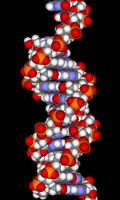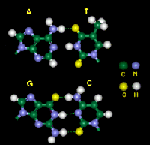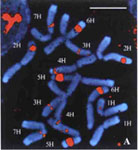Some questions to have your class consider:
What do you like to eat?
What plant products does your food contain?
Relate components of everyday foods to plant crops such as potatoes, wheat (for pasta, bread etc.), rice, fruit, and vegetables.
What happens to our food supply if the crop plants are not available for us to use?
Do crop plants only feed people?
How do we determine what components of foods provide the nutrition that we need and whether or not there are toxins or allergens present?
Scientists today are able to study the genetic code - DNA - of most living things. By comparing the codes from different organisms, scientists can predict what genes and proteins make an organism unique, i.e., what makes a tomato different from an apple. This gives us vital information about the food crop, such as its nutritional value, its potential ability to withstand the effects of invasion by other organisms and its predicted response to changes in the growing environment.
What is DNA? How is it structured? How do we extract it from organisms?
"> |
 |
Figure 1 - DNA double helix
(click to enlarge) |
Figure 2 - Schematic of DNA
(click to enlarge) |
James Watson and Francis Crick along with Maurice Wilkins received the Nobel Prize in Physiology or Medicine in 1962 for elucidating the structure of Deoxyribonucleic Acid (DNA) in 1953. It should also be noted that the key that allowed that discovery was provided by the amazing X-ray crystallographic images of DNA taken by Rosalind Franklin at King's College in London.
The DNA molecule is identified as a double-helix, meaning that it has two helical (spiral) backbone structures that are entwined around each other, similar to a ladder that has been twisted (Figure 1). The backbone consists of alternating units a specific sugar, called deoxyribose (dark blue in figure 2, figure 3) and phosphate molecules (light blue in figure 2, figure 3). Each rung of the ladder is made up of a pair of nucleotides (bases) held close together by weak hydrogen bonds. There are two bonds between the bases thymine (Fig. 2 -red, fig. 4) and adenine (fig. 2 - green, fig. 4) and three bonds between the bases guanine (fig. 2 - purple, fig. 4) and cytosine (fig.2 - light green, fig. 4).
 |
 |
Figure 3 - DNA backbone
(click to enlarge) |
Figure 4 - Pairing of bases
(click to enlarge) |
The bases always pair in the same manner as shown in figure 4, thus the sequence of bases on one strand can be used to determine the sequence of bases that will be on the other strand. The strands are complementary to each other. The structure of DNA is the same in every organism.
During cell division each new cell receives an exact copy of genetic information. The DNA helix unwinds during cell division and the weak hydrogen bonds are broken. Each strand then makes a copy of itself, a process termed replication. Each of these new DNA helices, comprised of one old strand and one new strand, then moves into the new cells as division continues. Therefore there is precise copying of the genetic code, or nucleotide base sequence, from one cell to its daughter cells.
Genes are found in specific areas of the DNA and are activated at the precise time that they are each needed for functions in the cell. The sequence of the bases along the strand is what determines the proteins that the organism will make when a gene is activated. Proteins are responsible for all of the activities that occur in cells.
Proteins consist of strings of amino acids that fold into very specific shapes which then determine how they will function in the cell. Each of the 20 amino acid that make up all of the known proteins is encoded by the nucleotide bases along the strands of DNA. A linear group of three nucleotides (triplets) codes for each amino acid.
There are four nucleotide bases interspersed along the DNA strand - Adenine (A), Thymine (T), Guanine (G) and Cytosine C). These four nucleotides can be arranged in 64 different 3-nucleotide combinations, or codons, which each code for an amino acid. Some amino acids thus have more than one triplet code. This Genetic Code was first identified in the early 1960's.
Table of Standard Genetic Code

|
Key to the Table of Standard Genetic Code |
| Alanine |
ALA |
A |
|
Arginine |
ARG |
R |
| Asparagine |
ASN |
N |
Aspartic acid |
ASP |
D |
| Cysteine |
CYS |
C |
Glutamic acid |
GLU |
E |
| Glutamine |
GLN |
Q |
Glycine |
GLY |
G |
| Histidine |
HIS |
H |
Isoleucine |
ILE |
I |
| Leucine |
LEU |
L |
Lysine |
LYS |
K |
| Methionine |
MET |
M |
Phenylalanine |
PHE |
F |
| Proline |
PRO |
P |
Serine |
SER |
S |
| Threonine |
THR |
T |
Tryptophan |
TRP |
W |
| Tyrosine |
TYR |
Y |
Valine |
VAL |
V |
| STOP = Termination Signal START = Start codon (ATG) |
DNA is found in different "packages" in prokaryotic and eukaryotic cells. In bacterial cells it forms a single loop-like structure, while in animal and plant cells the DNA is packaged into chromosomes (Figure 5). Chromosomes consist of DNA that is tightly wound around proteins called histones, and have other associated proteins that are important in regulating gene activity in the cell. The number of chromosomes in a cell varies among organisms The largest number of chromosomes is found in Ophioglossum reticulatum, a species of fern, with more than 630 pairs, whereas Myrmecia pilosula (an ant) only has 1 pair and humans (Homo sapiens) have 23 pairs.
 |
Figure 5 - Barley
chromosome pairs
(click to enlarge) |
The food that we consume contains DNA from the organisms which are used to make the food. For example, green beans are parts of plants, and therefore contain DNA. Chocolate is made from cocoa, which is the seed of a plant, and therefore contains DNA. Ham is from pigs and thus contains DNA. When this DNA enters our bodies it is rapidly broken down, or degraded, by the enzymes that are in our digestive systems. Our bodies use the proteins, fats, starches and sugars stored in the food cells to nourish us.
Go to Activity 1
Further information about DNA structure and function can be found at the following web sites:
http://ceprap.ucdavis.edu/acrobat/DNA_Structure_and_Function.pdf http://www.rothamsted.ac.uk/notebook/courses/guide/dnast.htm http://kentsimmons.uwinnipeg.ca/cm1504/dnareplication.htm
